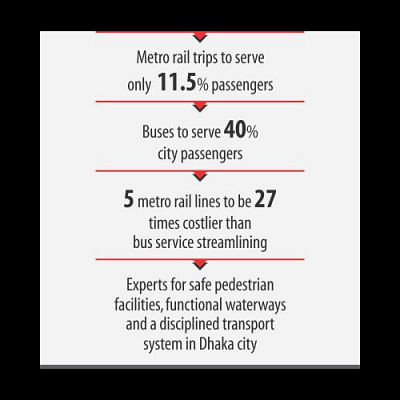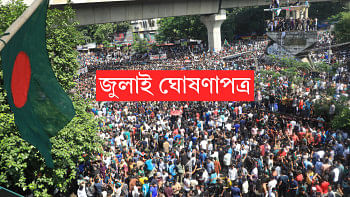Bus easier, cheaper

Once built two decades from now, the five metro rail lines costing around $27.6 billion would serve only 11.5 percent of city passengers, said experts citing the capital's transport master plan.
But if only $1 billion is spent for streamlining bus services, it will serve 40 percent of the passengers by the same time, said the draft of the final report on updating Dhaka's Detailed Area Plan, citing revised strategic transport plan (RSTP) valid from 2015 to 2035.
“In fact, rationalisation of bus service holds the key to resolving the capital city's transport demand and horrendous traffic chaos,” said SM Salehuddin, a transport expert on the committee for rationalising bus routes and disciplining the city's public transport system.
The estimated cost for building the five metro lines, according the city's RSTP, is $27.6 billion (Tk 2.32 lakh crore), said the draft. It excludes the operation and maintenance costs.
Streamlining -- disciplining, coordinating and synchronising -- bus services and routes would cost $1 billion, said the report.
On the plea of RSTP recommendations, the government with a Dhaka metro rail company embarked on implementing the five metro rail lines, one under construction, two at feasibility stage and two at conceptual stage.
Though an expensive and time-consuming option, building metro rails got priority as they are structurally impressive and earns political points for the government, said insiders.
Transport experts said the government should have given priority to recommendations on facilitating pedestrians (who would account for 25 percent of the journeys in 2035), bus service reforms, and traffic management to have immediate and much greater impact on ending the traffic chaos for a lot less money and in less time.
Completion of all five metro lines would take 24 years and the construction of the first one began in 2012.
The draft report on DAP (Detailed Area Plan) revision said Dhaka's traffic situation would turn terribly unmanageable by then if bus services were not streamlined, safe pedestrian facilities were not installed, non-motorised vehicles were not managed, the transport sector was not disciplined and waterways were not made functional.
It said instead of advancing expensive metro rail as a priority, it is imperative to go for measures that would require only a minimal financial involvement and far less time but would leave a massive impact on transport system improvement.
The report highly recommends rearrangement of priorities for pedestrian-friendly transport policy, utilisation of waterways, commuter rail service, and developing multi-mode transport system.
Anisur Rahman, a traffic engineer of Dhaka Transport Coordination Authority (DTCA), in a presentation on World Cities Day in late October last year, said by the year 2035, the population in the 1,625sqkm Rajuk area would be over 26 million and the total daily trips would be 51 million.
Citing the RSTP, he said by 2025, the total daily trips in greater Dhaka city would be around 43 million, of which metro line-6 and -1 and Bus Rapid Transit line-3 together would carry only 6 percent of the people.
If bus services were streamlined, buses would carry 63 percent of the people.
Md Abdul Baquee Miah, additional project director of Dhaka Mass Transport Company Limited for the country's maiden metro line-6, however thinks that there are no sufficient well-planned bus routes in the capital city to offer comprehensive mass transport service.
Introduction of metro rail will discourage use of small private cars that are considered as a foremost reason behind traffic congestion in the capital, he said.
Noted civil engineer Prof Jamilur Reza Choudhury, who steered the 2005 Strategic Transport Plan, believes that metro rail would by and large serve as a major transport corridor.
“But no system will yield results unless traffic is disciplined and pedestrian facilities are developed,” he said.
The DTCA is the custodian of Strategic Transport Plan, considered the transport master plan of the metropolitan and greater Dhaka city area.
Its Executive Director Khandakar Rakibur Rahman said, “It is difficult for me to say how a priority of an urban transport scheme is set. However, the implementation directive for the metro rail and Bus Rapid Transit [BRT] scheme came from the prime minister.”
As to why disciplining the capital's traffic system and freeing Dhaka's streets and pedestrian passages are not prioritised, he said, “The answer is obvious and known to all, I don't want to specify.”

 For all latest news, follow The Daily Star's Google News channel.
For all latest news, follow The Daily Star's Google News channel. 








Comments